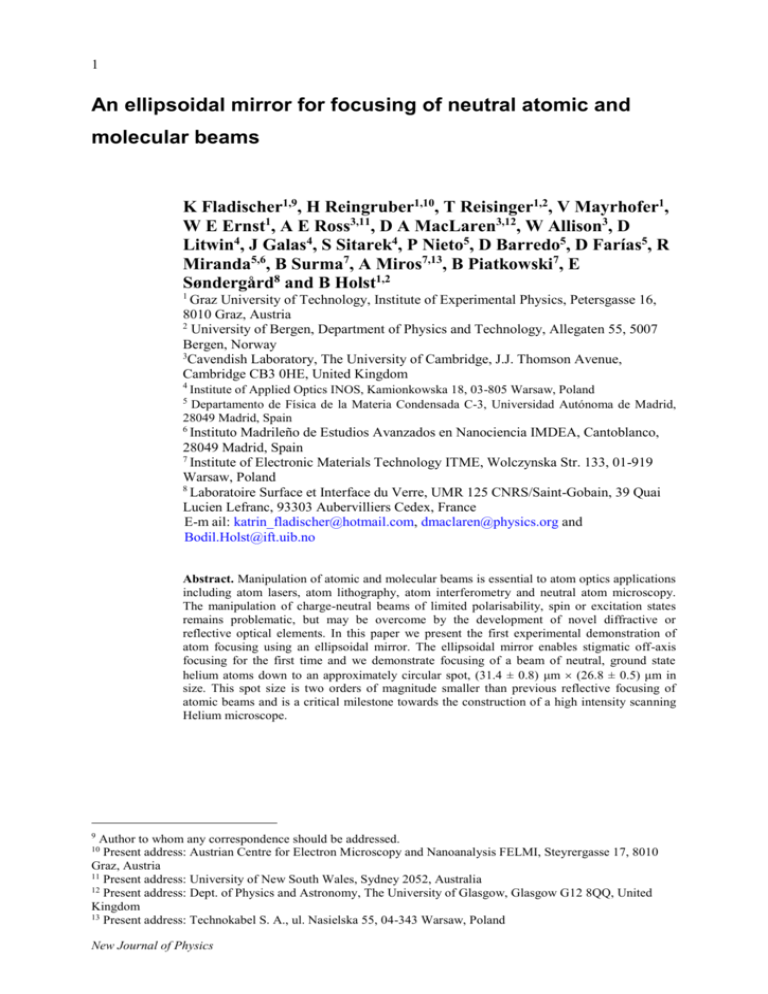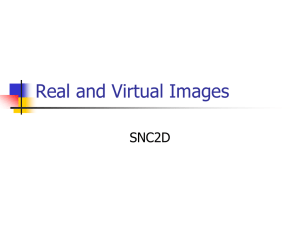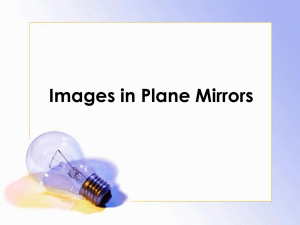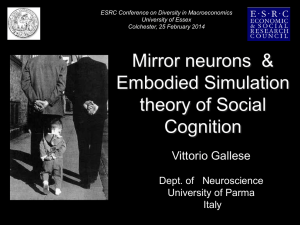An ellipsoidal mirror for focusing of neutral atomic and
advertisement

1 An ellipsoidal mirror for focusing of neutral atomic and molecular beams K Fladischer1,9, H Reingruber1,10, T Reisinger1,2, V Mayrhofer1, W E Ernst1, A E Ross3,11, D A MacLaren3,12, W Allison3, D Litwin4, J Galas4, S Sitarek4, P Nieto5, D Barredo5, D Farías5, R Miranda5,6, B Surma7, A Miros7,13, B Piatkowski7, E Søndergård8 and B Holst1,2 1 Graz University of Technology, Institute of Experimental Physics, Petersgasse 16, 8010 Graz, Austria 2 University of Bergen, Department of Physics and Technology, Allegaten 55, 5007 Bergen, Norway 3 Cavendish Laboratory, The University of Cambridge, J.J. Thomson Avenue, Cambridge CB3 0HE, United Kingdom 4 Institute of Applied Optics INOS, Kamionkowska 18, 03-805 Warsaw, Poland Departamento de Física de la Materia Condensada C-3, Universidad Autónoma de Madrid, 28049 Madrid, Spain 5 6 Instituto Madrileño de Estudios Avanzados en Nanociencia IMDEA, Cantoblanco, 28049 Madrid, Spain 7 Institute of Electronic Materials Technology ITME, Wolczynska Str. 133, 01-919 Warsaw, Poland 8 Laboratoire Surface et Interface du Verre, UMR 125 CNRS/Saint-Gobain, 39 Quai Lucien Lefranc, 93303 Aubervilliers Cedex, France E-m ail: katrin_fladischer@hotmail.com, dmaclaren@physics.org and Bodil.Holst@ift.uib.no Abstract. Manipulation of atomic and molecular beams is essential to atom optics applications including atom lasers, atom lithography, atom interferometry and neutral atom microscopy. The manipulation of charge-neutral beams of limited polarisability, spin or excitation states remains problematic, but may be overcome by the development of novel diffractive or reflective optical elements. In this paper we present the first experimental demonstration of atom focusing using an ellipsoidal mirror. The ellipsoidal mirror enables stigmatic off-axis focusing for the first time and we demonstrate focusing of a beam of neutral, ground state helium atoms down to an approximately circular spot, (31.4 ± 0.8) μm (26.8 ± 0.5) μm in size. This spot size is two orders of magnitude smaller than previous reflective focusing of atomic beams and is a critical milestone towards the construction of a high intensity scanning Helium microscope. 9 Author to whom any correspondence should be addressed. Present address: Austrian Centre for Electron Microscopy and Nanoanalysis FELMI, Steyrergasse 17, 8010 Graz, Austria 11 Present address: University of New South Wales, Sydney 2052, Australia 12 Present address: Dept. of Physics and Astronomy, The University of Glasgow, Glasgow G12 8QQ, United Kingdom 13 Present address: Technokabel S. A., ul. Nasielska 55, 04-343 Warsaw, Poland 10 New Journal of Physics 2 Contents 1. Introduction 2 2. Experimental Setup 3 3. Results and Discussion 5 4. Conclusions 7 Acknowledgements 7 References 7 1. Introduction The field of atom optics has developed rapidly in recent years [1-4]. A general challenge is the controlled manipulation of beams of atoms and molecules, which is typically approached using techniques related to photonics or magnetic fields [5]. For example, lasers are applied in cooling experiments and static light fields or magnetic fields are used to focus or diffract atomic and molecular beams [6]. Thus, even for inert species such as helium, hexapole magnets have been successful in weakly-focusing atomic beams of 3He [7] and metastable 4He [8]. Common to all these techniques is that they exploit “internal properties” of the atoms or molecules, such as their polarizability, spin, charge or atomic excitations. However, for charge-neutral, ground-state particles with very weak polarizability and no spin, such as ground-state helium-4, alternative methods must be found. A method that can be applied in such cases is to use nanostructured optical elements, conceptually similar to those used in classical optics, to manipulate the atoms via diffraction and/or reflection. A number of such experiments have been presented over the years. One of the earliest was Keith et al [9], who used a nano-structured transmission grating in a gold foil to diffract a beam of atomic sodium. In [10] a nano-fabricated grating was applied to show the existence of helium dimers and in [11] to demonstrate the quantum behaviour of C60. Most recently, a classical Poisson Spot experiment was performed for the first time with neutral matter waves, using a beam of deuterium molecules and a nano-fabricated circular stop of silicon nitride [12]. When it comes to neutral atom focusing, as in classical optics, we may consider two main classes of optical element: transmission and reflection elements. The former are experimentally complicated, since they must be made as relatively large-scale, but free-standing nano-structures. Fresnel zone plates with free-standing rings have been used to focus a beam of neutral helium atoms down to a spot size of less than 2 µm [13, 14] and have also been applied to focusing deuterium molecules [15] and metastable helium [16]. The focused helium beam in [13] was subsequently used to obtain the first microscopy image using neutral atoms as an imaging probe. Two main advantages of using helium as an imaging probe are: (i) the low energy of thermal helium atoms, typically 15 meV – 100 meV, compared to hundreds of eV for electrons of comparable de Broglie wavelength and wave-vector; and (ii) that helium atoms are uncharged and chemically inert. Consequently, fragile samples can be looked at without damage and insulating materials can be investigated without the need for a conductive coating. Helium atom scattering (HAS) has been a well established surface characterisation tool for the last 30 years, providing information on solid surface structures as well as dynamic phenomena such as adsorbate kinetics and surface phonons [17-20]. There are two main disadvantages of applying Fresnel zone plates in atom optics. Firstly, at most 12.5% of the incident beam goes into the first order focus [21], which sits on a broad, zeroth-order background, reducing the signal to noise ratio. Secondly, the numerical aperture of a zone plate suitable for focusing angstrom de-Broglie wavelengths is limited by technical restrictions to at most a few hundred microns in diameter, thereby strongly collimating the millimetre-diameter beams produced by conventional atom beam sources. Thirdly, zone plates suffer from chromatic aberrations. This is a problem in atom optics because it is generally not possible to make high intensity beams with a narrow velocity distribution. A recent paper [15] shows that with the beam techniques presently New Journal of Physics 3 available, the highest resolution possible for a helium microscope employing a zone plate is around 500 nm. These disadvantages can, in principle, be overcome using a focusing mirror. A focusing mirror does not suffer chromatic aberrations and the mirror surface can be made to subtend a far larger fraction of a broad incident beam. For example, a hydrogen beam has been focused using a rotating liquid-helium covered hemispherical quartz mirror [22]. So far, two experiments on neutral helium atom focusing using reflection from solid mirrors have also been reported [23, 24]. The first demonstrated one-dimensional focusing whilst the second achieved two-dimensional focusing, with a focused beam diameter of (210 ± 50) µm. A limitation of the latter experiment was its use of a centrosymmetric mirror design within an off-axis scattering configuration, causing astigmatism and limiting the minimum focused beam diameter. As we will show, substantial improvements can be achieved with the introduction of a stigmatic, ellipsoidal mirror. 2. Experimental Setup Figure 1. Section view of the beam apparatus MAGIE. The helium beam is generated by selecting the central part of a supersonic expansion from the nozzle with a microskimmer. The beam propagates along the optical axis to the mirror and illuminates an area limited by a collimating aperture. The beam is focused to a spot that can be profiled using a two-dimensional piezo table and detected by an electron impact ioniser detector. The angle between the source chamber and the detector is 90°. The chopper can be used to chop the beam for energy resolved surface scattering experiments but is not used in this paper. The experiments presented here were all carried out in the molecular beam apparatus MAGIE. For a detailed description of the apparatus see [25]. Figure 1 shows a sketch of the experimental setup. A neutral, ground-state helium beam was created by supersonic expansion from a 10 µm nozzle. Measurements were made at a source pressure of (100 ± 1) bar. The nozzle temperature was kept at (120.0 ± 0.2) K for all experiments, corresponding to a beam energy of (26.7 ± 0.3) meV with a velocity spread of about 1%.The central part of the supersonic beam expansion region was selected using a micro-skimmer of (46 ± 1.5) µm in diameter. The micro-skimmer was produced by pulling a glass capillary tube using a commercial puller [26]. According to reference [27] the effective size of the beam source for subsequent optical calculations can be taken to be the micro-skimmer diameter. At the mirror, the atoms are in the molecular flow regime, travelling along non-interacting, divergent trajectories. The beam was incident at an angle of (45.0 ± 0.2)° on the mirror and the spot size on the mirror, limited by an upstream 300 µm aperture, was 656 µm in the x direction 464 µm in the y direction (for the mirror coordinate system see figure 2 (b)). The distance between the mirror and the New Journal of Physics 4 source was 1500 mm. The beam was focused by the mirror onto an image plane at a distance of 670 mm, where it hit a cross-piece aperture consisting of a vertical and a horizontal slit (5 µm 3 mm) mounted on a piezo table. The slits were scanned over the focus with sub-micrometre resolution to determine the corresponding focus size in two dimensions. The beam was detected using an electron impact ioniser mounted with a magnetic mass selector and a channeltron electron multiplier. Figure 2. (a) An ellipsoidal Cartesian surface focuses each ray coming from the object point into an image point. (b) The coordinate system for the ellipsoidal mirror (x, y, z) and for the image plane (x’, y’, z’). The origin of the mirror coordinate system is the point of reflection of the central ray on the mirror surface. Figure 3. Schematic diagram of the ellipsoidal mirror. A silicon single crystal wafer is grounded and a positive voltage is applied to the electrode structure. The silicon wafer is clamped between two sapphire apertures, each 0.25 mm thick. An additional sapphire plate 0.25 mm thick (not shown) is placed on top of the electrode structure, so that the distance between the undeflected silicon wafer and the electrodes is 0.5 mm. To provide the desired Cartesian surface the lower and upper apertures are elliptical. The desired macroscopic shape of the mirror is determined by applying geometrical optics. The optimum shape is simply a segment of the appropriate “Cartesian surface,” a surface where all rays emerging from one focal point are reflected into the other focal point [28], as illustrated in figure 2 (a). In practice, an ellipsoidal mirror was created by electrostatic bending of a single crystal silicon wafer through a carefully-defined aperture. It was necessary to use a single crystal to ensure that the surface was smooth relative to the wavelength of the incident beam. Additionally, the single crystal wafer had to be very thin, about 50 µm thick, to provide the necessary elastic properties for repeated bending. For a more detailed discussion of this issue see references [29, 30]. Figure 3 shows a sketch of the mirror assembly. The assembly is essentially a parallel plate capacitor [29, 30]. A 50 mm diameter silicon single crystal wafer, electrically grounded, was clamped between two sapphire apertures with elliptical holes, and held above an electrode array. The aperture dimensions depend on the scattering geometry and stigmatic imaging requires the ratio of aperture New Journal of Physics 5 principal radii to be given by cos , for a beam incident at angle on the mirror [28]. For this setup the axes had the dimensions 30 mm and 21.2 mm. The electrode structure had an overall ellipsoidal shape similar to the holes in the sapphire apertures, but slightly smaller: 20.1 mm and 15.54 mm respectively. Calculations presented in [28] show that this gives the most favourable bending. To be able to compensate for wafer imperfections the electrode structure in the mirror holder (figure 3) actually consists of five separated electrodes, see [31]. Prior to operation, the bending behaviour of the crystal wafer was checked with a specially-constructed profilometer that allows in-vacuum measurements of the macroscopic shape with micrometer precision [32]. Figure 4 indicates the profile of the mirror under similar conditions to those used in the focusing experiment showing the ellipsoidal deflection of the silicon wafer given by the ellipsoidal boundary conditions of the sapphire apertures. Figure 4. Mirror profile measured in the profilometer [32] for a uniform applied voltage of 2700 V at the 5 electrodes. The x axis is along the major axis of the sapphire clamping aperture (see figure 3), the y axis along the minor axis and the wafer deflection is displayed in the z axis. (x, y, z) are the mirror coordinates of figure 2 (b). To obtain a stable surface in vacuum, the wafer was hydrogen passivated at the University of Cambridge as described in [33, 34]. It was then clamped in the mirror holder (figure 3) under argon atmosphere. The whole mirror assembly was placed in an argon filled transport container similar to [35] and shipped to the Institute of Experimental Physics in Graz-Austria. Here the atom mirror was mounted again under argon in MAGIE on a special holder made out of PEEK (polyetheretherketone, from Allectra GmbH) to electrically insulate the atom mirror from the apparatus. A limitation of the present mirror that has not been discussed so far is that the specular reflectivity of the hydrogen passivated silicon surface turned out to be rather low. The best value reported for helium and for molecular hydrogen is about 3% [33], considerably less than the 12.5% expected to go into the focus when applying a zone plate. The low reflectivity is also the reason why we could not apply a smaller source diameter in these experiments. However, a recent result [36] reports a novel Si(111) coating of quantum stabilized lead of magic height which increases the specular reflectivity to 20%, promising high intensity atomic and molecular beam focusing in the near future. 3. Results and Discussion Figure 5 shows the best focus obtained. The focus has a full width at half maximum (FWHM) of (26.8 ± 0.5) µm (31.4 ± 0.8) µm along the main axes x’ and y’ (for the coordinate system see figure 2 (b)). A constant voltage V was applied to the electrode structure. To experimentally determine the New Journal of Physics 6 focal size, the beam was scanned in the horizontal and the vertical direction with slits (5 µm x 3 mm) in steps of 1 µm. The measured signal was then de-convoluted with the slit function and the horizontal and vertical scan were combined to show a three dimensional image of the focus. The best focus was obtained with a voltage of 2760 V. This is less than theoretically predicted [28] but was later attributed to insufficient clamping of the silicon crystal, leading to an initial, irreversible slip of the crystal in the mirror holder. Figure 5. In (a) and (b) the measured He intensities are presented (circles) with a fit (grey line) to determine the actual best full with at half maximum. These scans were done with slits in the piezo table along the axes x’ and y’. In (c) the best helium beam focus is shown in a three-dimensional representation. The voltage applied to all electrodes was 2760 V. Figure 6. Thickness map of the used Si(111) wafer used in this experiment. The thickness map was recorded using the instrument described in [37]. Given an ideal Cartesian surface for the setup the expected magnification, given by the ratio of object-mirror and mirror-image distances, is –0.45. Consequently the ideal focus would have a diameter of (20.6 ± 0.7) µm. This is a little smaller than what we actually achieve, but compared to the best focus that could be obtained under similar conditions with a parabolic mirror: “a disc of least confusion” of about 230µm in diameter, the improvement is very significant. The value for the “disc of least confusion” was calculated using the raytracing formalism of [38]. It should also be noted that New Journal of Physics 7 the ideal Cartesian surface is not completely symmetrical along the x-axis (see fig. 2. a). Since the electrode structure in this experiment is completely symmetrical this is not something which is compensated for in these experiments. This fits with the fact that the focus is slightly worse along the x-axis than in the perpendicular direction. The deviation from the ideal focus of the smallest measured focus can also be attributed to the inhomogenities in flatness of the Si(111) wafer. As shown in figure 6 the Si(111) wafer exhibits thickness variations of 3 µm. 4. Conclusions In this paper we have presented the first focus of a beam of neutral helium atoms achieved with an ellipsoidal mirror. The focus has a size of (31.4 ± 0.8) µm times (26.8 ± 0.5) µm along the main elliptic axis. Taking into account the experimental set up magnification of –0.45 the best obtainable focus would be (20.6 ± 0.7) µm. The difference between these two values we attribute to the fact that the ideal Cartesian surface is not completely symmetrical and to imperfections such as thickness variations and warp in the silicon wafer used in the experiments, both effects can be compensated in future experiments. Acknowledgements This work was supported by the European Commission, FP6, NEST ADVENTURE program, Project INA, Contract 509014. Further support was obtained from the Polish Ministry of Education and Science. We gratefully acknowledge everybody who was involved in the INA project and contributed to its success. A special thank is due to the workshops at TU Graz and the Cavendish Laboratory, Cambridge. References [1] Steuernagel O 2009 Optical lenses for atomic beams Phys. Rev. A 79 013421 [2] Libson A, Riedel M, Bronshtein G, Narevicius E, Even U and Raizen M G 2006 Towards coherent control of supersonic beams: a new approach to atom optics New Journal of Physics 8 77 [3] Wohlfart K, Grätz F, Filsinger F, Haak H, Meijer G and Küpper J 2008 Alternating-gradient focusing and deceleration of large molecules Phys. Rev. A 77 031404 [4] Arndt M, Szriftgiser P, Dalibard J and Steane A M 1996 Atom optics in the time domain Phys. Rev. A 53 3369-78 [5] Roach T M, Abele H, Boshier M G, Grossmann H L, Zetie K P and Hinds E A 1995 Realization of a magnetic mirror for cold atoms PRL 75 629-32 [6] Adams C S, Sigel M and Mlynek J 1994 Atom optics Phys. Rep. 240 143-210 [7] Jardine A P, Fouquet P, Ellis J and Allison W 2001 Hexapole magnet system for thermal energy 3He atom manipulation Rev. Sci. Instrum. 72 3834-41 [8] Chaustowski R R, Leung V Y F and Baldwin K G H 2007 Magnetic hexapole lens focusing of a metastable helium atomic beam for UV-free lithography Appl. Phys. B 86 491-6 [9] Keith D W, Schattenburg M L, Smith H I and Pritchard D E 1988 Diffraction of atoms by a transmission grating Phys. Rev. Lett. 61 1580-5 [10] Schöllkopf W and Toennies J P 1996 The non-destructive detection of the helium dimmer and trimer J. Chem. Phys. 104 1155-8 [11] Nairz O, Arndt M and Zeilinger A 2003 Quantum interference experiments with large molecules Am. J. Phys. 71 319-25 [12] Reisinger T, Patel A A, Reingruber H, Fladischer K, Ernst W E, Bracco G, Smith H I and Holst B 2009 Poisson’s spot with molecules Phys. Rev. A 79 053823 [13] Koch M, Rehbein S, Schmahl G, Reisinger T, Bracco G, Ernst W E and Holst B 2008 Imaging with neutral atoms – a new matter-wave microscope Journal of Microscopy 229 1-5 [14] Doak R B, Grisenti R E, Rehbein S, Schamhl G, Toennies J P and Wöll Ch 1999 Towards realization of an atomic de Broglie microscope: helium atom focusing using Fresnel zone plates Phys. Rev. Lett. 83 4229-32 [15] Reisinger T and Holst B 2008 Neutral atom and molecule focusing using a Fresnel zone plate J. Vac. Sci. Technol. B 26 2374-9 [16] Carnal O, Sigel M, Sleator T, Takuma H and Mlynek J 1991 Imaging and focusing of atoms by a Fresnel zone plate Phys. Rev. Lett. 67 3231-4 [17] Hulpke E 1992 Helium Atom Scattering from Surfaces (Springer Series in Surface Science vol 27) Springer Germany New Journal of Physics 8 [18] Scoles G 1988 Atomic and Molecular Beam Methods Oxford University Press [19] Benedek G and Toennies J P 1994 Helium atom scattering spectroscopy of surface phonons: genesis and achievements Surface Science The First Thirty Years (North-Holland) vol 299/300 ed Duke C B pp 588-611 [20] Farías D and Rieder K H 1998 Atomic beam diffraction from solid surfaces Rep. Prog. Phys. 61 1575-1664 [21] Rehbein S 2001 Entwicklung von freitragenden nanostrukturierten Zonenplatten zur Fokussierung und Monochromatisierung thermischer Helium-Atomstrahlen Ph.D. thesis University of Göttingen, Institute for Xray Physics Germany [22] Berkhout J J and Walraven J T M 1993 Scattering of hydrogen atoms from liquid-helium surfaces Phys. Rev. B 47 8886-904 [23] Doak R B 1992 Experimental limitations and opportunities in single-phonon inelastic helium scattering Helium Atom Scattering from Surfaces (Springer Series in Surface Science vol 27) ed Hulpke E (Springer Germany) pp 5-24 [24] Holst B and Allison W 1997 An atom-focusing mirror Nature 390 244 [25] Apfolter A 2005 Wiederaufbau und Test einer He-Streuapparatur und erste Streuexperimente an amorpher sowie kristalliner SiO2 -Oberfläche M.Sc. thesis Graz University of Technology, Institute of Experimental Physics Austria [26] Braun J, Day P K, Toennies J P, Witte G and Neher E 1997 Micrometer-sized nozzles and skimmers for the production of supersonic He atom beams Rev. Sci. Instrum. 68 3001-9 [27] Reisinger T, Bracco G, Rehbein S, Schmahl G, Ernst W E and Holst B 2007 Direct images of the virtual source in a supersonic expansion J. Phys. Chem. A 111 12620-8 [28] MacLaren D A, Allison W and Holst B 2000 Single crystal optic elements for helium microscopy Rev. Sci. Instrum. 71 1-13 [29] MacLaren D A, Holst B, Riley D J and Allison W 2003 Focusing elements and design considerations for a scanning helium microscope (SHeM) Surf. Rev. Lett. 10 249-55 [30] MacLaren D A, Goldrein H T, Holst B and Allison W 2003 Phase-stepping optical profilometry of atom mirrors J. Phys. D: Appl. Phys. 36 1842-9 [31] Weeks A E 2007 Si(111) Atom-Optical Mirrors for Scanning Helium Microscopy Ph.D. thesis University of Cambridge, Cavendish Laboratory UK [32] Fladischer K, Litwin D, Galas J, Weeks A E, MacLaren D A, Lammegger R, Sormann H, Ernst W E and Holst B 2008 An optical profilometer for characterizing complex surfaces under high vacuum conditions Prec. Eng. 32 182-5 [33] Barredo D et al. 2007 Si(111)-H(1x1): A mirror for atoms characterized by AFM, STM, He and H-2 diffraction Surf. Sci. 601 24-9 [34] MacLaren D A, Curson N J, Atkinson P and Allison W 2001 An AFM study of the processing of hydrogen passivated silicon(111) of a low miscut angle Surf. Sci. 490 285-95 [35] MacLaren D A, Curson N J, Atkinson P, Holst B, Johnson D J and Allison W 2002 Simple design for the transportation of ex situ prepared hydrogen passivated silicon J. Vac. Sci. Technol. A 20 285-7 [36] Barredo D, Calleja F, Nieto P, Hinarejos JJ, Laurent G, Vázquez de Parga A L, Farías D and Miranda R 2008 A quantum-stabilized mirror for atoms Adv. Mat. 20 3492 [37] Weeks A E, Litwin D, Galas J, Surma B, Piatkowski B, MacLaren D A and Allison W 2007 Accurate surface profilometry of ultrathin wafers Semicond. Sci. Technol. 22 997-1002 [38] Wilson R J, Holst B and Allison W 1999 Optical properties of mirrors for focusing of non-normal incidence atom beams Rev. Sci. Instrum. 70 2960-7 New Journal of Physics






